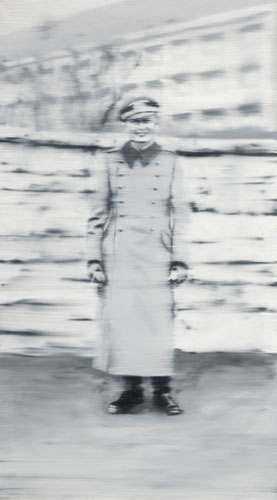The word "thrilling" is generally not the first word that comes to mind in describing the life of a book editor. But I will say that when it comes to exhibition catalogues, there are two moments that come close.
The first is when the books arrive in our offices. It's amazing how all the hard work and late nights seem to dissipate the moment the book is in hand. (It's a bit like giving birth, but instead of inhaling the scent of new baby, we inhale the scent of fresh ink.) The second is witnessing the installation process itself—a transformation from the two-dimensional page to the three-dimensional space.

Gerhard Richter, Onkel Rudi (Uncle Rudi), 1965, oil on canvas, photo courtesy Památník Lidice/Lidice Memorial
It takes more than a year for a catalogue to be edited, designed, proofread, printed, bound, and shipped. During that time, editors become very familiar with descriptions of artworks, but of course we can only view the artworks themselves as reproductions. (And even then, the actual images can arrive surprisingly late in the process—sometimes months after we've edited the very text that describes them.) Consequently, artworks take on a certain presence of their own in an editor's mind, which means that those first visits to the galleries can be full of surprises. For example, Gerhard Richter's Uncle Rudi: during the editing of the catalogue for Art of Two Germanys/Cold War Cultures, it had assumed larger-than-life dimensions for me. But it isn't six or seven feet high, as I had envisioned; it's less than half that—a small, stunning painting that compels the viewer to lean in close to squint at this blurry figure standing cheerfully in his SS uniform.
When I interviewed curator Stephanie Barron, she mentioned a number of other works that may come as a surprise to visitors...
[vimeo vimeo.com/2915063]
Sara Cody, Editor



